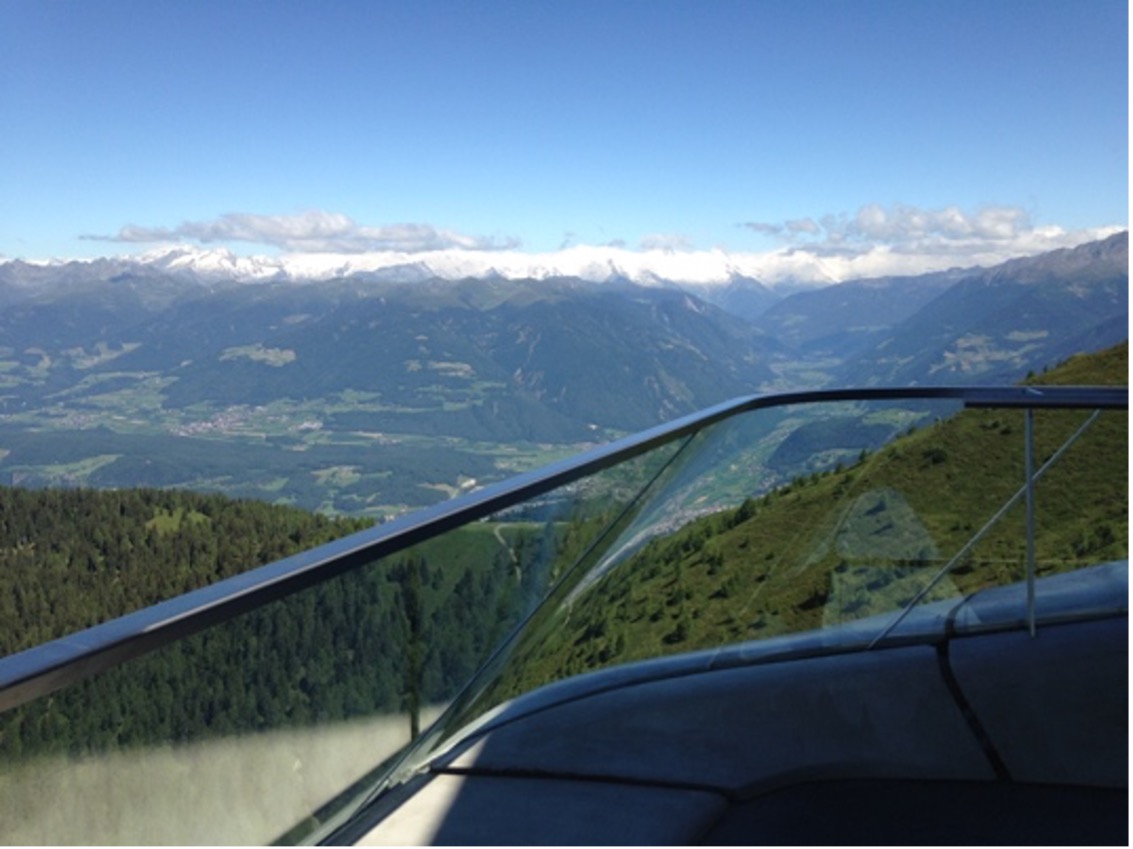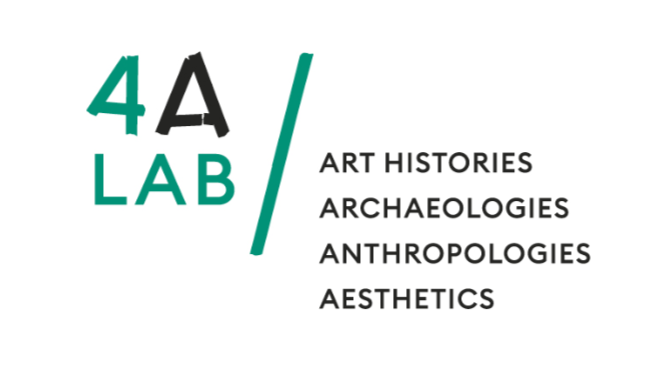Architectures, Media Library, Spatial Orders
The Alps as a Central Periphery? Recordings from a Research Trip along the Brenner Pass
By its very nature, a crossroads is a place you pass through, briskly moving onwards to the final destination of your journey. This podcast, curated by Emily Neumeier, provides a tantalising glimpse into one of Central Europe’s busiest border zones and mountain crossings—the Brenner Pass. A polyvocal account in eight acts based on a research trip of the Max-Planck Research Group “Objects in the Contact Zone – The Cross-Cultural Lives of Things” across Italy and Austria.
06.04.2021

The land route across the Brenner Pass is one of the four great crossings in the Central European Alps. It cuts through a mountain ridge that constitutes the geographical watershed between the Black Sea and the Adriatic. The Brenner has seen traffic since the Stone Age—Roman troops passed through it on their way north, and the first proper road was constructed under Septimus Severus (145–211 CE). Later in the medieval period, it became an important trade route connecting Mediterranean markets with the merchant cities of northern Europe. It was through this route that Dürer and Goethe headed towards their Italian adventures. In 1867, the first railway line across the main ridge of the Alps was built through the Brenner Pass. In 1920, the border between Italy and Austria was set up on its cusp to divide the long-contested region of Tyrol between the two nations. During the late 1930s and early 1940s, the Brenner route became an important section of the fascist “axis” connecting Berlin to Rome. Since the 1950s, the Brenner and the surrounding regions have become a focal point of the European unification process. This divided yet intrinsically connected—and connecting—region has proved an important foci in terms of cultural integration: its paramount role in the formation of the European Union is witnessed by the implementation of important architectural and infrastructural projects on its territories, such as the “Europabrücke”—a motorway bridge spectacularly carved into the alpine landscape near Schönberg—and the “Europakapelle”—a chapel built to commemorate the workers who lost their lives in fatal accidents when the motorway was under construction. On the one hand, these modern development projects testify to the ever-increasing importance of the route; on the other hand, they indicate that the area around the Brenner Pass, despite its centrality, seem to have gradually turned into a mere transit zone, losing some of its local significance. Yet, in recent years, the Brenner has gained new prominence as one of the main trails through which refugees and migrants from the Mediterranean route find their way to Central and Northern Europe. In 2016, debates over the construction of a fence to shut down this paradigmatic “inner European” border revealed to what measure global movements and dynamics are intrinsically linked to the identity of Europe and its central regions.
Due to its historical and present significance, in 2016 the Brenner Pass was chosen as the site of a five-day working retreat of the Max-Planck-Research Group “Objects in the Contact Zone – The Cross-Cultural Lives of Things.” The research group, whose work focused on the historical conditions and institutional frameworks of transcultural exchange, gathered students and postdoctoral researchers from different backgrounds and with diverse research focuses. Part of the group embarked on a train ride from Florence to Innsbruck, where they were expected to meet some colleagues from abroad to present and mutually discuss their work. The retreat was combined with a few site visits in the region, which were meant to help participants reflect on, and put into question, the narrative of the Alps as a “global crossroad.” This podcast documents and curates some of the informal discussions and observations gathered in the context of the Brenner working retreat; it seizes the momentum of collecting “raw material” on the fringes of personal perspectives and academic personae—something that usually remains at the margins of academic formats, despite forming an important substrate to our ideas and their development. By capturing the ambient sounds of a particular place, or recording the spontaneous comments of a person standing in front of an artwork, podcasts provide a “behind the scenes” view of research as it unfolds on the ground. It is a maxim of art history that scholars should write about what they have seen with their eyes; while this is not always possible due to political, economic, or bureaucratic constrictions, every art historian knows the special alchemy that takes place during fieldwork: seeing an object or building in context puts the brain into overdrive, making it possible for us to form impressions or interpretations that would not come forth otherwise. This podcast aims to provide insights into this very process. We thus invite you to discover the rich material and surprises that the Brenner Pass—a contact zone in every sense of the term—has to offer.
Act 1: On the Train
We begin our journey by boarding the train in Florence, heading north to the border with Austria. Some of the group members regularly commute on this route back and forth from Italy to Germany; this gives us the chance to discuss how they experience the landscape of Northern Italy from a distance, looking out the train window. We also recount close encounters that have allowed us to experience the landscape through someone else’s eyes—which is especially relevant at the height of the Syrian refugee crisis.
Act 2: The Messner Museum
The Messner Mountain Museum in Corones is dedicated to celebrity climber Reinhold Messner and his philosophy of alpinism, which he considers as the “supreme discipline of mountaineering.” One need to take a cable car to reach the site—a concrete behemoth dramatically perched on the summit of Kronplatz Peak, designed by the late Zaha Hadid. We try to make sense of this personal manifesto for the preservation of tradition presented in a contemporary “mountain museum” setting.
Act 3: The Brenner Pass
As the group makes its way through the Brenner Pass—today on a towering motorway—we cross the invisible border between Italy and Austria. While taking a lunch break at a rest stop along the road—a high-end affair recently constructed to replace the customary checkpoint between the two states—we reflect on how the dissolution of borders within the Schengen Zone has transformed the area.
Act 4: Europakapelle
The construction of the Europa Bridge in 1963, which conveys a 777-meter long stretch of the highway snaking through the Brenner Pass, was acclaimed as a symbol of both modern infrastructure and the European unification process. The Europakapelle is a modernist chapel commemorating the 22 workers who died bringing the bridge to fruition. We visit the site to take view of the cycle of frescoes that decorate the exterior and interior of the site; along the way, we get to discover other haunting myths and local legends about loss and hardship in this point of passage.
Act 5: Innsbruck Panorama
The Tyrol Panorama is a 360-degree immersive painting depicting a key event in the history of the Brenner region: the 1809 battle between the Napoleonic troops and the Tyrolean rebels fighting against foreign occupation. Painted in 1869, on the occasion of the 50th anniversary of the battle, the Panorama can still be seen today in a museum erected on the original site of the battle. Through this artwork, we observe how notions of local identity have shifted from the mid-19th century to 2011, the year the museum was established.
Troelenberg, Emily Neumeier.
Act 6: Ottoman Spoils at Schloss Ambras
A 16th-century Renaissance castle in Innsbruck, Schloss Ambras originally served as the seat of power for Archduke Ferdinand II (1529–1595). A few years back, the caretakers of the palace—today a museum—decided to recreate a Turkenkammer in the archduke’s armory. The exhibition space displays a myriad of objects seized by the Ottoman forces during the battles for the subjugation of the Austrian territories. Besides offering a meditation on the longstanding orientalist fascination with the “other,” the present exhibition portrays Tirol as a land at the intersection between not only North and South, but also East and West.
Act 7: Ferdinandeum
Moving forward with our program, we pay a visit to the “object friends,” both old and new, housed at the Ferdinandeum, the state museum of Tyrol colloquially named after Archduke Ferdinand II. We take part in an exhibition on Renassiance portraits, where we are surprised to discover that the famous Innsbruck plate—a masterpiece of medieval Islamic craftsmanship and one of the highlights of the museum collection—is on loan. In front of an empty display case, we yet manage to discuss how this medieval masterpiece still holds many secrets, from its original place of production to its provenance.
Matthias Weiß, Eva-Maria Troelenberg, Emily Neumeier.
Act 8: Tyrolean State Library
Finally, librarian Roland Sila introduces us to the collections of the local state library. The group asks Selan to reflect on the changing role of libraries, including their function in making collections more accessible and their serving as tangible, material archives for the memories and objects of the local community. We dive into the history of the massive book collection of Andreas Alois diPauli (1761–1839), a longtime public servant of Tyrol; besides reflecting the tastes of the local elite, the collection speaks of the secularization of knowledge in the 19th-century Brenner region.
